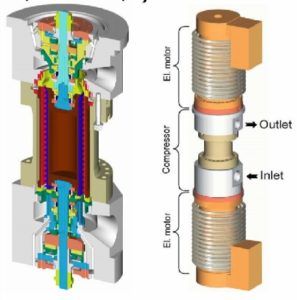What the subsea compression projects in Norway tell us

Gullfaks subsea wet gas compressor[/caption]
The world’s first subsea gas compression facilities started production at the Åsgard field in September 2015. The main system components are inlet cooler, “bulk separator”, compressor with aftercooler and a liquid pump. Fouling deposits in compressor flow paths are removed by injection of liquid at the compressor inlet. The Åsgard Subsea Compression is based on the MAN HOFIM centrifugal compressor unit which is a hermetically sealed oilfree turbocompressor. The unit contains active magnetic bearings, no shaft seals (oil free) and an integrated high speed VSD motor.
This article contains excerpts from the paper, “Offshore experience with thermal turbomachinery in Norwegian petroleum industry through 50 years. A review of major milestones, lessons learned and impacts,” by Arne Lynghjem, Lars E Bakken and Tore Naess.
The motor is directly coupled to the barrel type compressor. Both the motor and bearing cavities are cooled by filtered process gas. As the compressor inlet liquid content is very low, the liquid tolerant compressor design is acceptable i.e. the Gas Volume Fraction (GVF) = 1. The hermetically sealed unit has a combined rotor system for the compressor and the motor, and it is supported by three radial bearings. Only one single radial bearing in the compressor section is made possible because the adjacent motor bearing supports the combined motor and compressor rotor.
Consequently, the absence of a fourth radial bearing enable the unit to be very compact. It makes space available for the common axial bearing in the area between the compressor and motor. This location is advantageous because it avoids any heavy overhung weight and longer shaft than necessary. The bearing and rotor system therefore provide the stiffest rotor and best rotordynamic performance.
Two compressor units (2 x 11.5 MW) are installed in parallel. Power is supplied through a subsea cable from the Åsgard A platform power station. One topside transformer and one subsea transformer are required to provide the necessary motor power and frequency transfer over 40 km. The Åsgard subsea gas compression facilities has been in continuous operation since autumn 2015.
The Gullfaks subsea compression, which came on line a few months later than Åsgard, is the first multiphase compression system for wellstream to be installed at the seabed. The Gullfaks subsea installation covers two wet gas compressor units (2 x 5 MW) operated in parallel. The OneSubsea WGC4000 wet gas compressor unit (previously Framo WGC4000) is a contra rotating compressor type with alternating rows of impellers with no static diffusers between them. The design is compact and capable of compressing wet gas.
The unit is directly driven by two variable speed electric motors, which are contra rotating and liquid filled. Power, barrier fluid and lube fluid are supplied by a 15 km umbilical from the Gullfaks C platform. Important qualification of subsea process cooler, electric and vibration monitoring systems have been conducted as part of the project. The Gullfaks wet gas compressor is working with unprocessed well stream from a gas field, where liquid in form of condensate or water may typically represent 0-5 % of volume, i.e. Gas Volume Fraction (GVF) is 0.95-1. However, the subsea wet gas compressor is design to cover GVF 0-1.
First start up was in winter 2015/2016, and normal production started autumn 2017. The wet gas compression technology will extend the life of Gullfaks for about two years and extract an additional 22 million barrels of oil equivalents. The utilization of subsea compression has an estimated recovery increase from 62 to 74% for the field area involved.
The operational experience of Åsgard subsea compression is promising, showing a regularity of 99.9%. Based on the qualified Åsgard subsea compressor technology, a hermetically sealed oil-free turbocompressor for topside operation was installed and started up on the Ivar Aasen offshore platform in 2016. The next step in the development shall involve wet gas compression in Åsgard subsea compression - Phase 2. Increased pressure differential and increased wet gas content will be required in Phase 2 for the existing subsea compression system. To validate the compressor capability, full wet gas testing at K-Lab was performed autumn 2017 followed by installation and wet operation in 2018/19. The Gullfaks subsea compression has been in operation since autumn 2017 and has successfully compressed wet gas and unprocessed wellstream.









